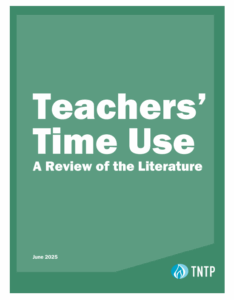Pay is a sensitive topic. Conversations about it can easily become proxy debates about the value of a person or a profession. Not surprisingly, teacher pay debates tend to be riddled with misunderstandings and misinformation, making it difficult to address the real problems with existing lockstep pay systems—or discuss common-sense alternatives. How do we separate fact from fiction when it comes to teacher pay? Earlier this week, we released Shortchanged, a new report on the consequences of how we pay the majority of teachers in this country. Today, we’ll look at some of the most common myths about performance-based teacher pay.
Myth: Basing salaries on experience and academic credentials is the only fair way to pay teachers.
Fact: Most districts now have multiple high quality options beyond experience and credentials for making pay decisions.
Setting teachers’ pay strictly on factors like experience or academic credentials may have been the only option before most districts had tools in place to assess teachers’ performance. But doing so is only about as “fair” as paying basketball players based on their height; it disregards the things that really matter, like talent, hard work and performance. It isn’t fair to the teachers who contribute the most to their schools and it isn’t fair to students who miss out on the chance to learn from great teachers who might have entered the profession or stayed longer. And while lockstep pay seems, on the surface, to be a good deal for more experienced teachers, it is deeply unfair to highly effective classroom veterans, who may work for decades alongside less effective colleagues without seeing any distinction in pay. Now that many states and districts have committed to multiple-measure evaluation tools, they are better equipped to align pay with performance than ever before. A truly fair way to pay teachers would take experience and academic background into account when they lead to demonstrated performance and success in the classroom, and many school systems are now in a position to put this into action, by aligning rigorous evaluation systems with compensation.
Myth: Performance-based pay has already been tried, and it hasn’t worked.
Fact: Very few districts have tried true performance-based pay, but where it’s been tried it seems to be working.
About 90 percent of school districts in the country use the traditional lockstep approach to teacher pay, which ignores classroom performance entirely. Most districts that have tried something different have simply added a small one-time bonus for strong performance on top of the same old lockstep salary schedule. The results have been predictably modest.
However, the few districts that have moved to smarter compensation systems have seen promising early results. A performance-based pay system in the District of Columbia Public Schools (DCPS) has helped the district retain more of its best teachers by awarding them large raises early in their careers. Teachers have the opportunity to make more than $100,000 by year four in the classroom, and as a result, dissatisfaction with compensation has become one of the least common reasons that highly effective teachers leave the district. In Tennessee, retention bonuses for highly effective teachers in high-need (or “priority”) schools have also shown promise. And the federal Talent Transfer Initiative, which offered financial incentives for teachers to transfer to high-need schools, showed some positive outcomes for students in the receiving schools, too.
Myth: Performance-based pay ignores the value of experience.
Fact: Performance-based pay can easily be structured to value experience when it is accompanied by strong performance.
In almost any school, some of the best teachers are also some of the most experienced. But not every experienced teacher is a great teacher. Likewise, some teachers with only two or three years of experience are already achieving outstanding results in the classroom. Performance-based pay doesn’t play favorites when it comes to experience or credentials. Instead, it provides the largest raises and bonuses to the teachers who are the most successful at helping students learn—no matter how they came to be so successful or how long it took them to get there. But in practice, more seasoned teachers in performance-based pay systems are still likely to earn more than less seasoned peers, because they will have had more years to demonstrate the strong performance that is most valued. However, not all seasoned teachers will earn more.
Myth: Performance-based pay will never work because it’s impossible to quantify great teaching.
Fact: The research base has become much stronger in recent years on the question of distinguishing levels of teacher performance. Evaluation systems that use multiple measures to rate teacher performance can help school systems recognize and reward those who are getting the best results in the classroom.
We now know that it is possible to identify great teachers using multiple-measure evaluation tools, and that those great teachers consistently produce better results than other teachers (even when students are randomly assigned to teachers). To make sure performance-based pay rewards great teachers at all experience levels, school systems need to engage their communities in building and implementing rigorous evaluation systems that paint more accurate and complete pictures of teacher performance based on multiple measures, such as classroom observations, student surveys, and evidence of students’ learning growth. It doesn’t have to be perfect before it becomes the basis for compensation (evaluation systems are always works in progress) and some districts, like Dallas and Washington, D.C., have chosen to undertake the hard work of implementing new evaluation and compensation systems at the same time. But when done well, both systems are thoughtfully sequenced, consistently implemented, clearly communicated and understood by educators. When evaluation systems are linked to compensation, it’s even more imperative that school leaders have the observation skills and tools necessary to avoid inaccurate ratings, and that teachers have a clear way to address any concerns with their evaluations.
Myth: Performance-based pay will create an unhealthy competitive culture in schools.
Fact: Teachers in the same school won’t be competing with one another for slices of a static pay pie because performance-based pay isn’t a zero-sum game.
If pay is based on performance, every teacher who performs well will earn more pay. There is no cap. If anything, performance-based pay has the potential to strengthen school cultures by boosting the retention of top teachers and attracting new talent, giving more teachers an opportunity to work with and learn from talented colleagues.
Myth: School systems can’t afford to move to performance-based pay without a large increase in funding.
Fact: School systems can implement performance-based pay by re-allocating existing funds.
Moving to a smarter compensation system does not require a sharp increase in funding. It does, however, require that school systems make a fundamental choice: Do they want to pay for years of service, advanced degrees and everything else they are currently buying with the money they allocate to teacher salaries? Or do they want to pay for great teaching? Doing both is not an affordable option.
School systems that decide to pay for great teaching can afford to do it because they will no longer be constrained by the rigid boundaries of lockstep compensation. Over time, the money that funded raises for ineffective teachers or automatic increases for master’s degrees can be used to fund performance-aligned pay.







